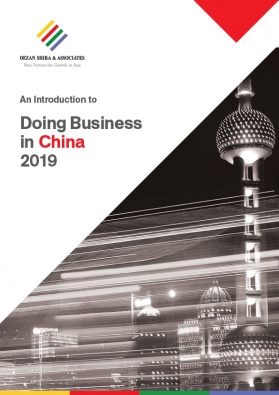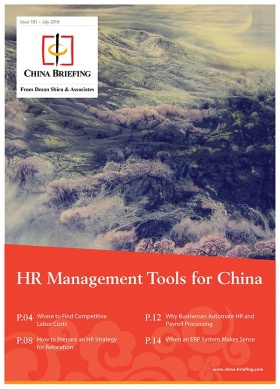China Labor Market: Hiring Costs, Job Preferences, Talent Acquisition

China has the world’s largest labor market even though its working age population is shrinking. China Briefing looks at key aspects of the country’s labor market in 2019, focusing on labor costs, job preferences among the youth, and the distribution of local talent.
As the US-China trade war drags on, the Chinese economy is weathering a slowdown. Growth projections, factory output, export-import statistics, and other economic indicators all show that the Chinese economy is facing its biggest test since the 2008 global financial crisis.
Consequently, the Xi Jinping government is championing support for small and medium enterprises (SME) through tax cuts, lowering social insurance costs, as well as other benefits to improve overall confidence in the economy.
These concessions are crucial to China’s overall stability. They aim to prevent discontent over declining job prospects as much as they seek to incentivize businesses – jobs growth is fundamental to China’s socioeconomic and, thus, political stability.
In 2019, China wants to create 11 million urban jobs – the same target as last year, when it eventually succeeded in creating 13.2 million jobs.
Here we discuss key aspects of China’s labor market in 2019 that will impact hiring sentiment and jobs growth in the country.
Labor costs in China
China’s economy has been growing steadily for a long time, peaking in 2007 at over 14 percent and posting 10 percent growth in 2010. Until 2015, China was the fastest growing economy in the world, but has since witnessed a decline in growth rates – showing an average growth rate of 6.5 percent in the last five years.
A direct result of this growth trajectory has been rising living expenses, especially in major cities, leading to a corresponding rise in labor costs.
As China’s economy matures, it is also producing more high-skilled labor, pushing up overall wage growth. This was illustrated by an early 2019 report by supply chain procurement solutions firm GEP, which stated that median wages in certain Chinese cities now surpass those in parts of Eastern Europe.
The wage growth has been proven by other comparative data as well in recent years. In 2017, the China Economic Review stated that China’s average wage had trebled between 2005 and 2016 to reach a level higher than in emerging economies like Brazil, Argentina, and Mexico.
According to the 2018 Report on Chinese Employers’ Demand and the Supply of White-Collar Talent in Summer, released by Zhaopin, a leading job recruitment platform, the top three average white-collar wages in China are: Beijing, Shanghai, and Shenzhen, with average monthly wages at RMB 10,531 (US$1,543), RMB 9,796 (US$1,435), and RMB 9,309 (US$1,364), respectively. Guangzhou was ranked fifth with an average white-collar average wage of RMB 8,019 (US$1,175), just behind Hangzhou with an average wage of RMB 8,585 (US$1,258).
Meanwhile, in the manufacturing sector, the average hourly wage in China surpassed US$3.60 in 2016, putting it on par with Portugal and South Africa; this was five times the existing wage rate in India. The same year, manufacturing wages fell from US$2.90 per hour to US$2.70 in Brazil, from US$4.30 to US$3.60 in South Africa, and US$2.20 to US$2.10 in Mexico.
However, the wage growth in China has outstripped gains in productivity. Consequently, firms have either relocated to cheaper destinations, offset costs by laying off workers, or are increasing investments in capital intensive production technology, such as intelligent manufacturing, industrial robots, and automation machinery.
Moreover, since social stability is at the crux of China’s policy making, social insurance benefits and minimum wages continue to see consistent growth every year. As of February 2019, the monthly minimum wage in Shanghai, Guangdong, Beijing, Tianjin, Jiangsu, and Zhejiang all exceeded RMB 2,000 (US$298). To alleviate these pressures on employers, authorities in Beijing are making various moves to lower social welfare costs, especially for SMEs.
In December 2018, the State Council announced 50 percent unemployment insurance refunds for companies that did not lay off staff or kept redundancies to a minimum. The refunds were higher for firms facing temporary operational difficulties.
This year, regional governments have been directed to lower social insurance obligations for businesses to the extent possible – depending on the local government’s funding needs and the support required for the economy. The move follows Premier Li Keqiang’s pledge at the Two Sessions meetings.
In addition, China plans to cut the employers’ share of basic pension premiums for urban workers from 20 to 16 percent and has extended the policy of reducing unemployment and work-related injury insurance premiums to April 2020.
Factors shaping job preferences
The services sector has become a leading employer in China – across all segments. According to the National Bureau of Statistics, the services sector, also known as the tertiary industry, accounted for half of China’s output in the third quarter of 2018. This is not surprising as Beijing attempts to maneuver China’s economy towards the services sector, besides developing capabilities in upstream manufacturing and innovation-based enterprise.
In terms of key trends, workers in China are seeking more flexibility and freedom – a departure from long hours at the production line. There is a newfound reluctance, particularly among young rural labor migrants, to work steady factory jobs.
For instance, low skilled migrant workers are beginning to actively prefer jobs in the delivery services segment – even if it means only earning between RMB 5,000 (US$745) and RMB 7,000 (US$1,043) a month. While they earn less as couriers, workers say they have greater time for themselves and more flexible – and less physically demanding – working conditions than if they worked on the factory floor or in associated jobs.
Moreover, with growth slowing on the coasts and the government incentivizing industries to move inward, many migrants are now opting to move inland to be closer to home. Overpopulated Tier-1 cities like Beijing have begun to evict lower skilled migrants, even labeling them ‘low-end population’, and are talking about introducing population caps.
In the case of higher skilled work – the young generation of Chinese are increasingly university educated and have higher aspirations for their careers. Overwhelmingly, they prefer white collar jobs. Chinese graduates prefer jobs in the education, consulting, internet, e-commerce, and media and culture industries, according to a December 2018 employment report by Zhaopin. The report also said that in the internet and e-commerce industry, the pool of candidates grew faster than job openings.
Nevertheless, despite being attractive to job seekers, workers in these sectors have become frustrated at the absence of a work-life balance due to a ‘996’ work schedule. Jack Ma, the founder of China’s e-commerce giant Alibaba, controversially defended the grueling ‘9am to 9pm, six days-a-week work schedule’, particularly for young Chinese as “a huge blessing that many companies and employees do not have the opportunity to have”.
On their part, there is growing resentment in the tech industry where several firms have cut back on benefits, bonuses, and jobs as they deal with China’s worst economic slowdown in nearly three decades. Still, jobs in technology startups remain highly sought after; competition for job vacancies intensified in 2019 with an average applicants-to-jobs ratio of 32 to 1, according to a talent supply and demand report from Zhaopin.
Distribution of local workforce
China’s workforce peaked in 2015 and has since been shrinking. A product of China’s one-child policy, 18 percent of the country’s population crossed the retirement age in 2018 – around 249 million citizens. Put in perspective, that’s close to three quarters of the US population. Still, China’s labor market is the largest in the world with a working-age population of close to a billion.
Here, the problem for recruiters has been the steady availability of sufficiently qualified hires. In many job fairs across China’s major cities, most hiring is now advertised for upstream segments in the IT, engineering, and electronics sectors – not for cheap factory work. Meanwhile, most workers being laid off in China are in low-tier manufacturing and in the construction industries due to rising costs, the trade war, and uneven urbanization.
China’s ageing labor market essentially means that the homegrown talent base is limited in some sectors more than others. Wang Qian, co-founder and head of commercial strategy at Maimai, a China-based career and social networking platform, says the number of unfilled AI positions in China reached about five million in 2018. Last year, a report published in the Taiwan-based DigiTimes predicted that China could face a talent shortfall of 400,000 people in its semiconductor industry by 2020.
Besides demographic pressures, China also has a unique geographic restraint when it comes to hiring labor. Its hukou system limits the free movement of labor across the country. Hukou is a legal document in China that records a holder’s permanent resident and basic personal information and determines the holder’s individual and family access to education, healthcare, jobs, and other benefits.
Mainly, the hukou program has distorted China’s labor market. It has placed a premium on certain professions and positions in its top tier cities at the cost of the free flow of labor, thereby creating idle capacity. At the same time, uneven economic development across the country has resulted in the historical concentration of labor market opportunities in top tier cities.
Consequently, China’s lower-tier cities are making efforts to attract young talent. Historically, the best-educated Chinese wanted to move to cities like Shanghai, Beijing, Guangzhou, and Shenzhen, but these have become quite expensive to live in. Today, second and third tier cities like Wuhan, Nanjing, Tianjin, Hangzhou, Shijiazhuang, and Xian are competing to attract talent by offering incentives like hukou and housing subsidies.
Moreover, as the Beijing leadership pushes employment policy as a priority, these cities will soon benefit from new directives to ease the movement of labor across the country.
This month, the National Development and Reform Commission asked all cities with a population under three million to lift restrictions on new domestic migrants. Cities with populations between three to five million have been directed to “comprehensively relax permanent residency requirements”.
Hukou reforms in the past have usually been in the form of patchwork policies, but with growing downward pressures on China’s economic growth – deploying its workers more effectively will be important.
About Us
China Briefing is produced by Dezan Shira & Associates. The firm assists foreign investors throughout Asia from offices across the world, including in Dalian, Beijing, Shanghai, Guangzhou, Shenzhen, and Hong Kong. Readers may write to china@dezshira.com for more support on doing business in China.
- Previous Article Residencia fiscal en China: aclaración sobre la regla de los seis años
- Next Article China to Cut US$45 Billion in Fees and Tariffs







